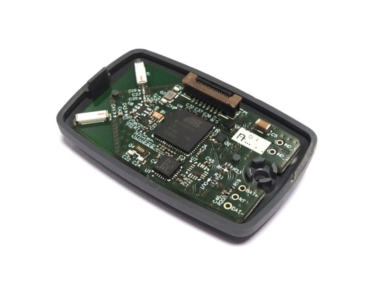Section: New Software and Platforms
Platforms
Zyggie: a Wireless Body Sensor Network Platform
Keywords: Health - Biomechanics - Wireless body sensor networks - Low power - Gesture recognition - Hardware platform - Software platform - Localization
Scientific Description: Zyggie is a hardware and software wireless body sensor network platform. Each sensor node, attached to different parts of the human body, contains inertial sensors (IMU) (accelerometer, gyrometer, compass and barometer), an embedded processor and a low-power radio module to communicate data to a coordinator node connected to a computer, tablet or smartphone. One of the system’s key innovations is that it collects data from sensors as well as on distances estimated from the power of the radio signal received to make the 3D location of the nodes more precise and thus prevent IMU sensor drift and power consumption overhead. Zyggie can be used to determine posture or gestures and mainly has applications in sport, healthcare and the multimedia industry.
Functional Description: The Zyggie sensor platform was developed to create an autonomous Wireless Body Sensor Network (WBSN) with the capabilities of monitoring body movements. The Zyggie platform is part of the BoWI project funded by CominLabs. Zyggie is composed of a processor, a radio transceiver and different sensors including an Inertial Measurement Unit (IMU) with 3-axis accelerometer, gyrometer, and magnetometer. Zyggie is used for evaluating data fusion algorithms, low power computing algorithms, wireless protocols, and body channel characterization in the BoWI project.
The Zyggie V2 prototype (see Figure 2) includes the following features: a 32-bit micro-controller to manage a custom MAC layer and process quaternions based on IMU measures, and an UWB radio from DecaWave to measure distances between nodes with Time of Flight (ToF).
E-methodHW: an automatic tool for the evaluation of polynomial and rational function approximations
Keywords: function approximation, FPGA hardware implementation generator
Scientific description: E-methodHW is an open source C/C++ prototype tool written to exemplify what kind of numerical function approximations can be developed using a digit recurrence evaluation scheme for polynomials and rational functions.
Functional description: E-methodHW provides a complete design flow from choice of mathematical function operator up to optimised VHDL code that can be readily deployed on an FPGA. The use of the E-method allows the user great flexibility if targeting high throughput applications.
Hybrid-DBT
Keywords: Dynamic Binary Translation, hardware acceleration, VLIW processor, RISC-V
Scientific description: Hybrid-DBT is a hardware/software Dynamic Binary Translation (DBT) framework capable of translating RISC-V binaries into VLIW binaries. Since the DBT overhead has to be as small as possible, our implementation takes advantage of hardware acceleration for performance critical stages (binary translation, dependency analysis and instruction scheduling) of the flow. Thanks to hardware acceleration, our implementation is two orders of magnitude faster than a pure software implementation and enable an overall performance improvements by 23% on average, compared to a native RISC-V execution.
Comet
Keywords: Processor core, RISC-V instruction-set architecture
Scientific description: Comet is a RISC-V pipelined processor with data/instruction caches, fully developed using High-Level Synthesis. The behavior of the core is defined in a small C code which is then fed into a HLS tool to generate the RTL representation. Thanks to this design flow, the C description can be used as a fast and cycle-accurate simulator, which behaves exactly like the final hardware. Moreover, modifications on the core can be done easily at the C level. Figure 3 depicts the place and route of a Comet core in a 28nm FDSOI technology.




